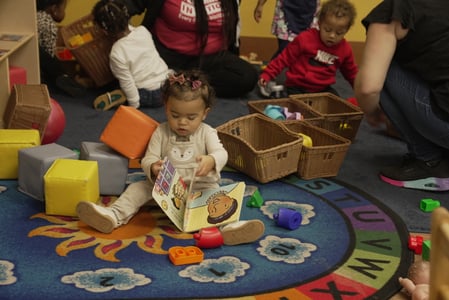
Successfully supporting infants and toddlers in your childcare program doesn't have to cost much, but it does require being intentional and curious. We recently put together an easy-to-use guide to help educators set up their learning spaces without breaking the bank, using materials they probably already have on hand. We also provide tips to help educators stay focused on the interactions that matter most in helping young children thrive.
Here, we will go over five things to remember as you support the growth and development of infants and toddlers. Whether you are looking to set up a supportive classroom or are just trying to use the resources you have better, we’ve got you covered. And don’t forget to share this resource to help your colleagues make the most of their classroom throughout the day.
1. Follow Children’s Lead
Following children’s lead will help you discover their preferences, interests, and developmental needs that will naturally support their development and learning, especially for children with disabilities. Narrate what you are doing and join children in their play. Finally, connect with your children’s families and integrate important elements of their home lives into classroom life.
2. Slow down
As adults, we may feel pressure to accomplish as much as we can during the day, but this doesn’t have to be so when working with children. Furthermore, checking off a long list of to-dos doesn’t usually equate to quality. Instead of focusing on the product, lean into the process.
Allow children to linger instead of rushing them to the next activity or station. Do they notice a new flower while walking outside? Are they looking at the clouds? Stop and observe with them. These moments of watching the world are learning, too.
3. Be Curious
A good learning environment doesn’t necessarily have to be filled with tons of fancy equipment to be effective. In fact, some environments quickly become distracting and irrelevant to a child's needs. Instead, lean into the learning environment you have and unlock its full potential with the power of curiosity.
Opportunities for curiosity abound!
- Notice cause and effect and point it out to your students by talking aloud (“Pushing the block caused it to fall!”).
- Encourage students to get curious about changes (“Why did the room get dark when the clouds came out?).
- Wonder out loud about how things work.
We may take the space we are in for granted because we have spent countless hours in classrooms, but remember that for many children, this is new! Modeling curiosity may very well be the key to bringing a space to life.
4. Provide intentional, organized, and accessible toys and materials
Classroom supplies can be one area that causes stress, especially for new teachers on a small classroom budget, but it doesn’t have to! Less is actually more, and how you use and organize materials can actually be more important than what you have.
Storage matters, and it doesn't have to be expensive! Using affordable clear bins can help students see items and unlock their creativity. Get strategic about how you store your classroom items so that they have the most impact. Grouping similar items together helps students learn how to use them.
Stretch how far toys and materials go by reducing and rotating. You don’t have to purchase lots of new toys. Instead, reduce the amount of toys available at a given time and rotate them in and out of the classroom depending on the children’s abilities and interests. Putting everything out all at once can be overwhelming. Instead, only use what is necessary at a time. You may find your children aren’t just excited about new toys, they can also get excited about old toys that they haven’t seen in a while!
5. Make use of open-ended materials
Just like a good learning environment leans into curiosity about our surroundings, good classroom materials lean into curiosity and spark the imagination. Provide sensory materials like playdough, textured fabric, and water. Incorporate supplies that inspire learning about our world, such as natural materials like seashells, pinecones, and rocks. While electronic toys may seem exciting, their predetermined functions actually limit children’s creativity. Open-ended materials, like paper and natural materials, allow children to use their imaginations to create something new.
Always remember to choose items that do not pose a choking hazard.
We are here to support you!
Check out this handy guide to support you as you organize (or reorganize) your classroom. Looking for more? Join us over at Teaching with CLASS, the podcast where we share positive, CLASS-powered tips to improve your teaching practice.
